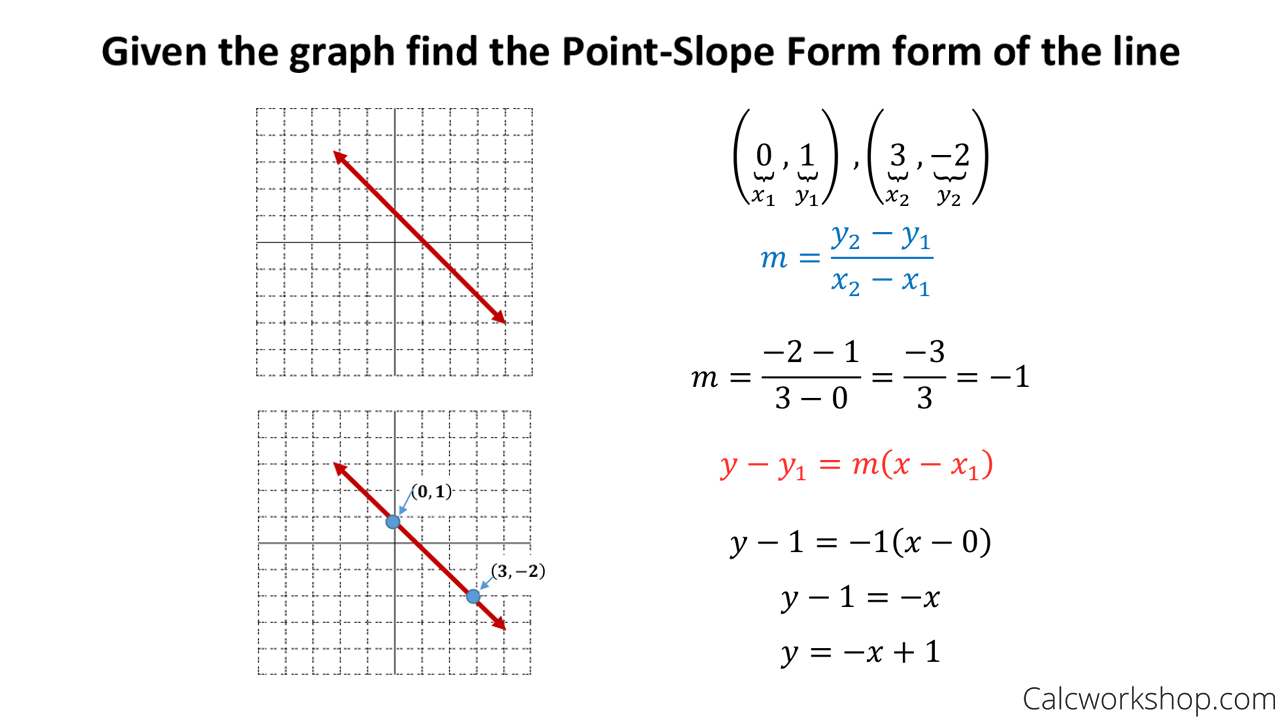The slope of a linear regression line is the vertical distance/the horizontal distance between any of the two points on this line. The Slope function returns the slope of a regression line based on the data points recognized by knownyvalues and knownxvalues. SLOPE Formula in Excel. SLOPE has two compulsory parameters, i.e., knowny’s. Point–slope form. A non-vertical line can be defined by its slope m, and the coordinates, of any point of the line. In this case, a linear equation of the line is = + (−), or = + −.

Purplemath
In the previous lesson, we saw the slope-intercept form for straight lines. The other format for straight-line equations is called the 'point-slope' form. For this one, they give you a point (x1, y1) and a slope m, and have you plug it into this formula:
Don't let the subscripts scare you. They are just intended to indicate the point they give you. You have the generic 'x' and generic 'y' that are always in your equation, and then you have the specific x and y from the point they gave you; the specific x and y are what is subscripted in the formula.
Content Continues Below
MathHelp.com
Here's how you use the point-slope formula:
Find the equation of the straight line that has slope m = 4 and passes through the point (–1, –6).

This is the same line that I found on the previous page, so I already know what the answer is (namely, y = 4x – 2). But let's see how the process works with the point-slope formula.
They've given me m = 4, x1 = –1, and y1 = –6. I'll plug these values into the point-slope form, and solve for 'y=':
y – y1 = m(x – x1)
y – (–6) = (4)(x – (–1))
y + 6 = 4(x + 1)
y + 6 = 4x + 4
y = 4x + 4 – 6
y = 4x – 2
Affiliate
This matches the result I got when I plugged into the slope-intercept form. This shows that it really doesn't matter which method you use (unless the text or teacher specifies). You can get the same answer either way, so use whichever method works more comfortably for you.
Point Slope Formula Def

Content Continues Below
You can use the Mathway widget below to practice finding a line equation using the point-slope formula. Try the entered exercise, or type in your own exercise. Then click 'Answer' to compare your answer to Mathway's. (Or skip the widget and continue with the lesson.)
Please accept 'preferences' cookies in order to enable this widget.
(Clicking on 'View Steps' on the widget's answer screen will take you to the Mathway site, where you can register for a free seven-day trial of the software.)
You can find the straight-line equation using the point-slope form if they just give you a couple points:
Find the equation of the line that passes through the points (–2, 4) and (1, 2).
I've already answered this one, but let's look at the process. I should get the same result; namely:
y = ( – 2/3 ) x + 8/3 ).
Given two points, I can always find the slope:
Then I can use either point as my (x1, y1), along with this slope I've just calculated, and plug these values into the point-slope form. Using (–2, 4) as the (x1, y1), I get:
y – y1 = m(x – x1)
y – (4) = ( – 2/3 )(x – (–2))
y – 4 = ( – 2/3 )(x + 2)
y – 4 = ( – 2/3 ) x – 4/3
y = ( – 2/3 ) x – 4/3 + 4
y = ( – 2/3 ) x – 4/3 + 12/3
Pt Slope Formula
y = ( – 2/3 ) x + 8/3
This is the same answer I got when I plugged the same information into the slope-intercept form on the previous page. So, unless your text or teacher specifies the method or format to use, you can (and should!) use whichever format suits your taste, because you'll get the same answer either way.
You can use the Mathway widget below to practice finding a line equation from two points. Try the entered exercise, or type in your own exercise. Then click 'Answer' to compare your answer to Mathway's. (Or skip the widget and continue with the lesson.)
Please accept 'preferences' cookies in order to enable this widget.

(Clicking on 'View Steps' on the widget's answer screen will take you to the Mathway site, where you can register for a free seven-day trial of the software.)
Affiliate
In the worked examples in the next section, I'll use the point-slope formula, because that's the way I was taught and that's what most books want. But my experience has been that many students prefer to plug the slope and a point into the slope-intercept form of the line, and solve for b. If that works better for you, then use that method instead.
URL: https://www.purplemath.com/modules/strtlneq2.htm

Comments are closed.